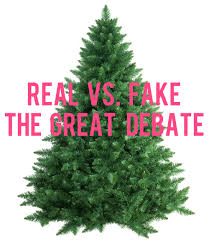Real or Fake: What’s Your Tree This Holiday Season?
Which way does your tree fall?

Ever since the Germans first introduced decorated Christmas trees in the 16th century, people around the world have expressed their excitement for the holiday season through brilliant evergreen displays. Many anxiously await the 1st day of December, when it is considered socially acceptable to have a Christmas tree and holiday decorations up. Although this deadline has already passed, there are still a few stragglers left who still need to get their act together. As they finally get around to decorating, one important choice looms ahead: Should I use a real or fake Christmas tree? Both types of trees offer their own pros and cons, but in the end it’s up to you as to what you’ll choose. If you don’t know the reasons why you should choose one or the other, I’m here to help with a breakdown of each tree.
Real trees are obviously the most conservative option, as artificial trees emerged 300 years after real ones. Real trees also offer an annual source of excitement, as getting to choose your Christmas tree is one of pure elation. Think you need a Christmas-scented candle? Don’t worry about it. The pine needles from your tree will fill your nose with the sweet scent of Christmas cheer mixed with pure ecstasy. An authentic tree provides a strong base and branches for you to hang as many ornaments as you’d like. However, having a real tree comes with a cost in a monetary and metaphorical sense. Pine needles can be messy and need constant sweeping up if you’re a neat freak. To protect your home, you have to make sure you place the tree in water so that it won’t dry out and become an easy fire hazard. Personally, I’m willing to put in the effort to mitigate this risk so I can have a more enriching holiday season, but I still have an obligation to break down fake trees for all of my fans.
If you’re strapped for cash, fake Christmas trees are the way to go. They’re also much lighter than real Christmas trees, so you can set it up all by yourself. If you’re not big into maintenance, there’s no need to worry with a fake tree. Yet, there are a lot of tradeoffs if you choose the fake route. These trees are not nearly as durable as real trees and are still a potential source of house fires. Craving the sweet scent of pine needles? Too bad, fake trees either don’t smell at all or give off a faint odor of plastic. Lastly, choosing a fake tree removes the opportunity to make memories with your family choosing your tree, but that only matters if you’re on the sentimental side.
In the end, the choice of real v. fake trees is one of convenience versus conventionality. I hope my insights propel you to have your best holiday season yet, or to at least be satisfied with your tree.







